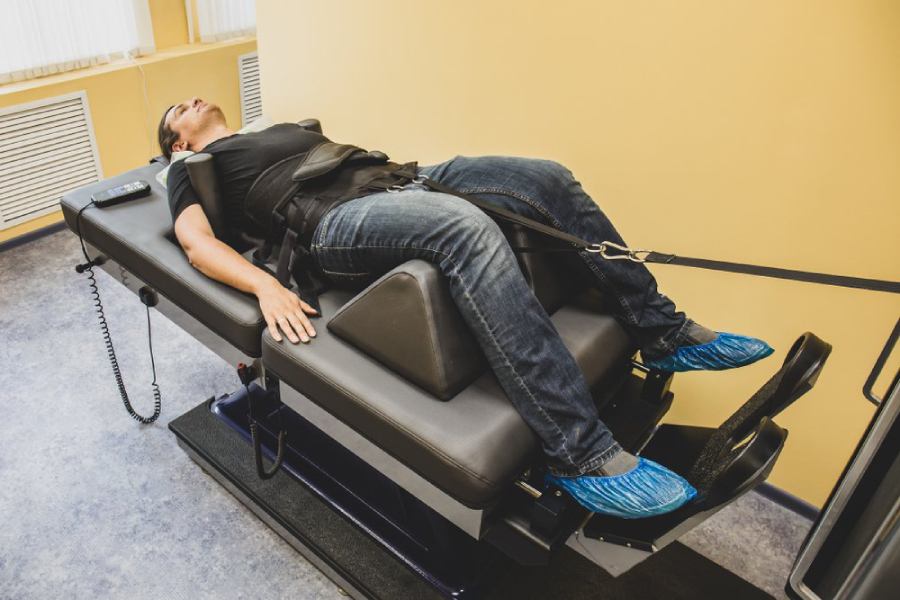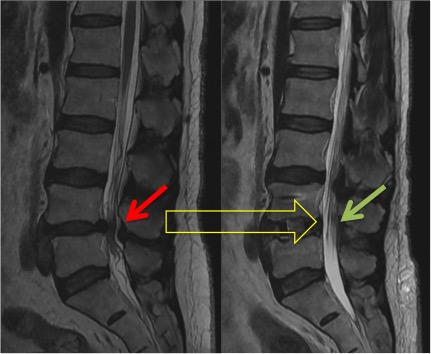Surgical and nonsurgical spinal decompression
Spinal decompression is removal of pressure from the nerve structures in the spine. It may be achieved with or without surgery. Nonsurgical decompression may provide temporary relief of symptoms but if pain persists, surgical decompression may be needed.
Let us look at some basics of spine anatomy, see how compression of the nerves may occur, and what decompression can do.
Normal spine anatomy
The spinal cord and nerves run in a canal formed by vertebrae, the spine bones. Square vertebral bodies lie in the front (anteriorly) and a thin layer of bone called lamina covers the spinal canal from the back (posteriorly). The spine bones are connected with discs in the front and small facet joints on the backside. Nerves exit the spine through neural foramina, natural gaps between the bones.

Figure 1 MRI of a normal spine. A - view from the side, B – cross section view
Anatomy of spinal stenosis
Narrowing of the spinal canal is called spinal stenosis. It may cause pressure on the nerves leading to pain, weakness and numbness in the legs and arms. You can learn more about conditions caused by spinal stenosis by reading the following articles on our website:

Figure 2 Narrowing of the spinal canal (stenosis) at L4-5
The most common cause of the spinal stenosis is arthritis of the spine (spondylosis). It starts with narrowing of the disc and leads to development of bone spurs and thickening of the ligaments. Other less common causes of stenosis include fractures, tumors, and infection.
Treatment of spinal stenosis: Decompression
The goal of decompression is to remove pressure from the nerves. This may be achieved in two ways: direct and indirect.
Direct decompression
Direct decompression always involves surgery to remove the bone spurs, disc bulges and thick ligaments compressing the nerves. The surgeon looks directly at the nerves and removes pressure from the nerves using sharp instruments. Examples of the direct decompression procedures include:
- Laminectomy;
- Discectomy;
- Foraminotomy.

Figure 3 Appearance of the spinal canal before and after direct decompression with laminectomy
Since direct decompression may affect stability of the spine, fusion may sometimes be required. Examples of these combined procedures are:
- Lumbar laminectomy and posterior instrumented fusion;
- TLIF – Transforaminal Lumbar Interbody Fusion.
Indirect decompression
Indirect decompression removes pressure from the nerves by pushing the spinal bones apart and by restoring the disc height. It may be achieved with surgical and nonsurgical techniques.
Nonsurgical indirect decompression is commonly used by physical therapist and chiropractors. It utilizes stretches, spinal manipulation and different traction devices: decompression machines, suspensions and inversion tables. It does not permanently change the spine anatomy but still may relief the symptoms of spinal stenosis. How long the relief lasts, varies between patients. The main benefit over the surgical decompression is that there are very few risks.
 |  |
| Figure 4 Spine decompression table | Figure 5 Inversion table |
Indirect surgical decompression involves realignment of the bones and fusing them in the corrected position to obtain stability. With the indirect surgical decompression a spacer is inserted between the vertebrae to push the bones apart, restore the disc height, and remove the pressure from the nerves.

Figure 6 Vertebral bodies are pushed apart by a cage during LLIF
You can see the result of indirect decompression in the picture below:

Figure 7 Spinal stenosis resolved after indirect decompression with LLIF
Examples of the indirect surgical decompression:
- LLIF – Lateral Lumbar Interbody Fusion
- ALIF – Anterior Lumbar Interbody Fusion
- ACDF – Anterior Cervical Discectomy and Fusion
Do you need surgical or nonsurgical decompression?
Because of the risks involved with surgery, I typically recommend trying conservative nonsurgical methods before turning to an operation.
However, there are some important exceptions. If there is progressive weakness and numbness, surgical decompression may be required because nonsurgical manipulation may delay appropriate treatment. In cases with compression of the spinal cord, manipulation may even be dangerous.
Join the many who've reclaimed their lives from back pain. With a focus on innovative and effective treatments, I'm here to guide you to a healthier, more comfortable future. See how by booking your consultation today. Don’t just take my word for it — discover the success stories of others like you.






